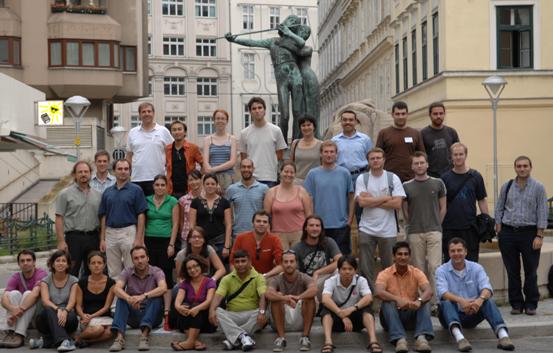

|
The 1st International Summer School on Computer Vision for Cultural Heritage was organized by the Pattern Recognition and Image Processing Group of the Vienna University of Technology as an activity of IAPR-TC19: Computer Vision for Cultural Heritage Applications. It was held in the beautiful city of Vienna at the Vienna University of Technology. The purpose of CVCH2007 was to bring together talented students from both image based sciences and Cultural Heritage research for a series of lectures and tutorials covering the current frontiers of applying computer vision technology to Cultural Heritage research and was aimed at PhD students and young academics who wanted to get seriously involved in new sensor technologies and methods for field recording and data capture. The summer school was split into a theoretical lecture part covering the topics: 3D scanning, 3D reconstruction and 3D surface modeling, Visualization and Virtual Reconstructions, and High Resolution Multispectral Imaging with applications in Cultural Heritage. For the practical part, students had the opportunity to work with the Time of Flight scanner: RIEGL LMS-Z420i, the Triangulation scanner: Konica Minolta VIVID 9i, the photogrammetry based scanner Breuckmann ‘smartSCAN 3D’ and the UV/VIS/nIR camera Hamamatsu C9300-124 to get experience with devices used for Cultural Heritage scanning. Due to the limited capacities for the practical scanning (6 groups of 5 people), participants of the summer school where selected based on academic record. The organizers received 45 applications of which 31 students from 16 different countries were accepted as participants for this international summer school. The organizers also tried to have a multidisciplinary group of students to stimulate discussions among them, which resulted in a group with main areas of expertise in Computer Vision, Computer Graphics, Archaeology, Photogrammetry, Civil Engineering, Architecture, and Heritage Management. With the generous support of EPOCH, the European Network of Excellence on ICT Applications to Cultural Heritage (see www.epoch-net.org), 19 students were partly supported financially by bursaries. The lectures at CVCH2007 where given by Angelo Beraldin, National Research Council of Canada (Three-dimensional Sensing and Modelling: Theory and Applications aimed at the Cultural Heritage sector), Martin Sauerbier, ETH Zürich, Switzerland (Photogrammetric 3D documentation and modeling of medium and large scale Cultural Heritage sites), Tomas Pajdla, Czech Technical University in Prague, Czech Republic (3D from Photographs, Towards a digital Langweil Model of Prague), and Martin Lettner, Vienna University of Technology, Austria (Multispectral Imaging (MSI) for Cultural Heritage Applications), which provided the technical background for the exercises with the scanning devices. The results of the work performed in the groups were presented by the students at the end of the summer school and are available in form of reports to be downloaded at the summer school homepage www.prip.tuwien.ac.at/cvch07 , where further material (presentation material, literature and photos) can also be found. A lively social evening program stimulated discussion among students, tutors and instructors and made the participants feel comfortable in the city of Vienna. |

|
1st Intl. Summer School on Computer Vision for Cultural Heritage 2007
Vienna, Austria August 20th - 24th, 2007
Report prepared by the CVCH2007 Chairs |

|
Summer School Chairs Robert Sablatnig and Martin Kampel, lecturer Angelo Beraldin with the participants of CVCH2007 in front of the Mozart fountain in Vienna, Austria. |